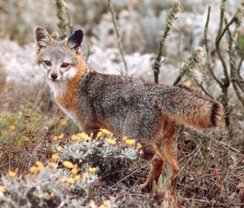Foxes native to a California island—and famous for having the least genetic diversity ever reported in a sexually reproducing animal—have some variation after all.

The San Nicolas Island foxes (Urocyon littoralis dickeyi) vary considerably in the genes coding for immune system compounds known collectively as the major histocompatibility complex (MHC), report Andres Aguilar of the University of California, Santa Cruz and his colleagues. These compounds help the immune system recognize intruders to the body.
The animals’ unusual pattern of carrying some uniform and some varying genetic material may have arisen from two factors. They are a near die-off of the fox population along with some evolutionary circumstance that strongly favored animals with unmatched versions of an MHC gene, the scientists argue in an upcoming Proceedings of the National Academy of Sciences.
The paper reopens an old debate about whether breeding programs to save endangered species should focus on MHC genes, says Bob Vrijenhoek of the Monterey Bay Aquarium Research Institute in California.
For more than a decade, Robert K. Wayne of the University of California, Los Angeles and various colleagues have been studying the foxes on islands off Los Angeles. In 1990 and again later, the researchers reported finding no diversity among the San Nicolas Island foxes. Each fox had two identical copies of each DNA segment examined.
Most of that work examined neutral DNA, repetitive bits that don’t seem to play a role in determining inherited characteristics and therefore don’t improve or reduce an animal’s reproductive success.
The recent decoding of the dog genome (SN: 9/27/03, p. 197: Letting the Dog Genome Out: Poodle DNA compared with that of mice, people) provided a map for finding genes that influence the fox’s characteristics. Aguilar then proposed checking the foxes’ variability in such functional genes rather than in the neutral DNA. “I told him he was wasting his time,” says Wayne.
However, when Aguilar examined an MHC gene, he found that 36 percent of foxes had inherited mismatched versions of the gene from their parents. Three DNA regions near MHC genes also showed strong heterogeneity, but another gene did not.
One of the lessons of this study is that neutral DNA markers “aren’t telling us enough of the story,” says Wayne.
On the basis of computer simulations of fox evolution, the researchers propose that the population shrank to as few as 10 breeding animals some 10 to 20 generations ago. After this period, called a genetic bottleneck, new generations of foxes would show great DNA uniformity.
The model could also produce high diversity in a particular gene, however. In this scenario, for a few generations, animals that inherit unmatched versions of a gene are much more fit than animals inheriting matched versions.
“It’s kind of a marvel to me,” says Wayne. “Natural selection . . . can preserve variation in the most desperate circumstances.”
Mix-match favoritism, called balancing selection, also shows up in sickle-cell anemia. People with two copies of a form of a particular gene develop sickle-cell anemia, but people with one copy of that form show high resistance to malaria.
A specialist in MHC genetics, Phillip Hedrick of Arizona State University in Tempe, cautions that the scenarios proposed in new fox work are “all inference.” He says, “It would be great if there were some more direct evidence.”






